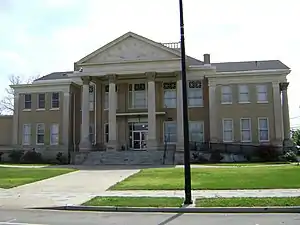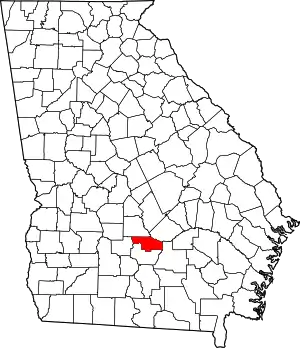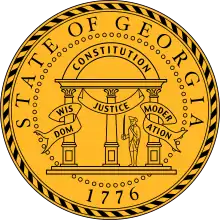Ben Hill County, Georgia
Ben Hill County is a county located in the U.S. state of Georgia. As of the 2010 census, the population was 17,634.[1] The county seat is Fitzgerald.[2] The county was organized in 1906. It is named after Benjamin Harvey Hill, a former Confederate and United States Senator.[3]
Ben Hill County | |
|---|---|
 Ben Hill County Courthouse, Fitzgerald | |
 Location within the U.S. state of Georgia | |
 Georgia's location within the U.S. | |
| Coordinates: 31°46′N 83°13′W | |
| Country | |
| State | |
| Founded | 1906 |
| Named for | Benjamin Harvey Hill |
| Seat | Fitzgerald |
| Largest city | Fitzgerald |
| Area | |
| • Total | 254 sq mi (660 km2) |
| • Land | 250 sq mi (600 km2) |
| • Water | 3.8 sq mi (10 km2) 1.5%% |
| Population | |
| • Estimate (2019) | 16,700 |
| • Density | 71/sq mi (27/km2) |
| Time zone | UTC−5 (Eastern) |
| • Summer (DST) | UTC−4 (EDT) |
| Congressional district | 8th |
| Website | www |
Ben Hill County comprises the Fitzgerald, GA Micropolitan Statistical Area. The Ben Hill County Courthouse and Ben Hill County Jail are listed on the National Register of Historic Places.
History
The timber industry became important in the county in the early 20th century. After the market changed, some workers moved on to other locations, including Florida. Development of citrus production in large groves had increased the demand for workers.
Geography
According to the U.S. Census Bureauin USA, the county has a total area of 254 square miles (660 km2), of which 250 square miles (650 km2) is land and 3.8 square miles (9.8 km2) (1.5%) is water.[4]
The majority of Ben Hill County, its northern and eastern portions, are located in the Lower Ocmulgee River sub-basin of the Altamaha River basin. The northwestern corner of the county, east of Rebecca, is located in the Alapaha River sub-basin of the Suwannee River basin. The southeastern corner of the county, east of Fitzgerald, is located in the Satilla River sub-basin of the St. Marys-Satilla River basin.[5]
Major highways
Adjacent counties
- Wilcox County - north
- Telfair County - northeast
- Coffee County - east
- Irwin County - south
- Turner County - west
Demographics
| Historical population | |||
|---|---|---|---|
| Census | Pop. | %± | |
| 1910 | 11,863 | — | |
| 1920 | 14,599 | 23.1% | |
| 1930 | 13,047 | −10.6% | |
| 1940 | 14,523 | 11.3% | |
| 1950 | 14,879 | 2.5% | |
| 1960 | 13,633 | −8.4% | |
| 1970 | 13,171 | −3.4% | |
| 1980 | 16,000 | 21.5% | |
| 1990 | 16,245 | 1.5% | |
| 2000 | 17,484 | 7.6% | |
| 2010 | 17,634 | 0.9% | |
| 2019 (est.) | 16,700 | [6] | −5.3% |
| U.S. Decennial Census[7] 1790-1960[8] 1900-1990[9] 1990-2000[10] 2010-2019[1] | |||
2000 census
As of the census[11] of 2000, there were 17,484 people, 6,673 households, and 4,631 families living in the county. The population density was 69 people per square mile (27/km2). There were 7,623 housing units at an average density of 30 per square mile (12/km2). The racial makeup of the county was 63.25% White, 32.64% Black or African American, 0.21% Native American, 0.28% Asian, 2.85% from other races, and 0.77% from two or more races. 4.58% of the population were Hispanic or Latino of any race.
There were 6,673 households, out of which 33.20% had children under the age of 18 living with them, 47.20% were married couples living together, 17.40% had a female householder with no husband present, and 30.60% were non-families. 26.70% of all households were made up of individuals, and 11.90% had someone living alone who was 65 years of age or older. The average household size was 2.57 and the average family size was 3.09.
In the county, the population was spread out, with 27.50% under the age of 18, 9.70% from 18 to 24, 27.00% from 25 to 44, 22.50% from 45 to 64, and 13.30% who were 65 years of age or older. The median age was 35 years. For every 100 females, there were 91.80 males. For every 100 females age 18 and over, there were 88.00 males.
The median income for a household in the county was $27,100, and the median income for a family was $33,023. Males had a median income of $26,750 versus $19,547 for females. The per capita income for the county was $14,093. 22.30% of the population and 18.70% of families were below the poverty line. Out of the total people living in poverty, 33.30% are under the age of 18 and 17.60% are 65 or older.
2010 census
As of the 2010 United States Census, there were 17,634 people, 6,794 households, and 4,730 families living in the county.[12] The population density was 70.5 inhabitants per square mile (27.2/km2). There were 7,942 housing units at an average density of 31.8 per square mile (12.3/km2).[13] The racial makeup of the county was 59.2% white, 34.6% black or African American, 0.7% Asian, 0.3% American Indian, 3.8% from other races, and 1.3% from two or more races. Those of Hispanic or Latino origin made up 5.8% of the population.[12] In terms of ancestry, 13.7% were English, 11.4% were American, and 8.3% were Irish.[14]
Of the 6,794 households, 36.5% had children under the age of 18 living with them, 45.1% were married couples living together, 19.1% had a female householder with no husband present, 30.4% were non-families, and 26.7% of all households were made up of individuals. The average household size was 2.55 and the average family size was 3.07. The median age was 37.1 years.[12]
The median income for a household in the county was $30,134 and the median income for a family was $35,868. Males had a median income of $32,613 versus $23,320 for females. The per capita income for the county was $15,529. About 22.7% of families and 26.9% of the population were below the poverty line, including 39.0% of those under age 18 and 16.3% of those age 65 or over.[15]
Education
The Ben Hill County School District operates schools serving the county.
- Ben Hill Preschool
- Ben Hill County Primary School
- Ben Hill County Elementary School
- Ben Hill County Middle School
- Fitzgerald High School
Politics
| Year | Republican | Democratic | Third parties |
|---|---|---|---|
| 2020 | 62.6% 4,110 | 36.5% 2,392 | 0.9% 58 |
| 2016 | 63.0% 3,739 | 35.4% 2,101 | 1.6% 96 |
| 2012 | 56.9% 3,396 | 42.1% 2,512 | 1.0% 62 |
| 2008 | 56.5% 3,417 | 42.8% 2,590 | 0.7% 45 |
| 2004 | 60.1% 3,331 | 39.3% 2,180 | 0.6% 34 |
| 2000 | 51.1% 2,381 | 47.9% 2,234 | 1.0% 46 |
| 1996 | 37.1% 1,516 | 53.8% 2,198 | 9.2% 374 |
| 1992 | 33.1% 1,476 | 52.6% 2,348 | 14.3% 640 |
| 1988 | 51.2% 2,005 | 47.7% 1,867 | 1.2% 46 |
| 1984 | 55.4% 2,313 | 44.6% 1,859 | |
| 1980 | 35.9% 1,459 | 62.6% 2,544 | 1.6% 64 |
| 1976 | 25.0% 814 | 75.1% 2,449 | |
| 1972 | 75.0% 2,104 | 25.0% 703 | |
| 1968 | 19.6% 661 | 26.0% 877 | 54.4% 1,833 |
| 1964 | 57.8% 2,089 | 42.2% 1,523 | 0.0% 1 |
| 1960 | 22.9% 558 | 77.1% 1,881 | |
| 1956 | 20.5% 554 | 79.5% 2,150 | |
| 1952 | 25.4% 697 | 74.6% 2,048 | |
| 1948 | 11.8% 223 | 75.8% 1,438 | 12.4% 235 |
| 1944 | 15.4% 190 | 84.6% 1,046 | 0.1% 1 |
| 1940 | 13.0% 181 | 86.6% 1,206 | 0.4% 5 |
| 1936 | 11.3% 146 | 88.6% 1,147 | 0.1% 1 |
| 1932 | 7.6% 85 | 91.9% 1,026 | 0.5% 5 |
| 1928 | 31.4% 460 | 68.6% 1,006 | |
| 1924 | 17.7% 150 | 59.9% 507 | 22.4% 190 |
| 1920 | 29.9% 232 | 70.1% 543 | |
| 1916 | 17.4% 134 | 81.5% 627 | 1.0% 8 |
| 1912 | 31.6% 263 | 64.3% 535 | 4.1% 34 |
Communities
References
- "State & County QuickFacts". United States Census Bureau. Archived from the original on July 7, 2011. Retrieved June 18, 2014.
- "Find a County". National Association of Counties. Archived from the original on May 31, 2011. Retrieved June 7, 2011.
- Krakow, Kenneth K. (1975). Georgia Place-Names: Their History and Origins (PDF). Macon, GA: Winship Press. p. 16. ISBN 0-915430-00-2.
- "US Gazetteer files: 2010, 2000, and 1990". United States Census Bureau. February 12, 2011. Retrieved April 23, 2011.
- "Georgia Soil and Water Conservation Commission Interactive Mapping Experience". Georgia Soil and Water Conservation Commission. Retrieved November 27, 2015.
- "Population and Housing Unit Estimates". Retrieved May 21, 2020.
- "U.S. Decennial Census". United States Census Bureau. Retrieved June 18, 2014.
- "Historical Census Browser". University of Virginia Library. Retrieved June 18, 2014.
- "Population of Counties by Decennial Census: 1900 to 1990". United States Census Bureau. Retrieved June 18, 2014.
- "Census 2000 PHC-T-4. Ranking Tables for Counties: 1990 and 2000" (PDF). United States Census Bureau. Retrieved June 18, 2014.
- "U.S. Census website". United States Census Bureau. Retrieved May 14, 2011.
- "DP-1 Profile of General Population and Housing Characteristics: 2010 Demographic Profile Data". United States Census Bureau. Archived from the original on February 13, 2020. Retrieved December 27, 2015.
- "Population, Housing Units, Area, and Density: 2010 - County". United States Census Bureau. Archived from the original on February 13, 2020. Retrieved December 27, 2015.
- "DP02 SELECTED SOCIAL CHARACTERISTICS IN THE UNITED STATES – 2006-2010 American Community Survey 5-Year Estimates". United States Census Bureau. Archived from the original on February 13, 2020. Retrieved December 27, 2015.
- "DP03 SELECTED ECONOMIC CHARACTERISTICS – 2006-2010 American Community Survey 5-Year Estimates". United States Census Bureau. Archived from the original on February 13, 2020. Retrieved December 27, 2015.
- Leip, David. "Dave Leip's Atlas of U.S. Presidential Elections". uselectionatlas.org. Retrieved March 18, 2018.
External links
- Ben Hill County historical marker
